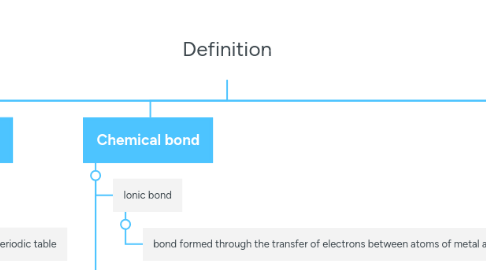
1. The structure of atom
1.1. Matter
1.2. Atom
1.2.1. The smallest particles of an element that can participate in a chemical reaction
1.3. Molecules
1.3.1. New node
1.4. Ion
1.5. Diffusion
1.6. Proton number
1.7. Nucleon number
1.7.1. The nucleon number of an element is the total number of protons and neutrons in its atom
1.8. Valence electrons
2. Periodic Table of Elements
2.1. Group
2.1.1. The vertical column in the periodic table
3. Chemical Formulae and equation
3.1. Relative atomic mass
3.1.1. The average mass of one atom of an element when compared with 1/12 of the mass of an atom carbon-12
3.2. Relative molecular mass
3.2.1. The average mass of one molecule when compared with 1/12 of the mass of an atom carbon-12
3.3. Relative formula mass
3.3.1. The average mass of one formula unit of the ionic substance when compared with 1/12 of the mass of atom carbon-12
3.4. Molar mass
3.4.1. The mass of 1 mol of the substance with the unit grams per mol or g mol -3
3.5. Mole
3.6. Molar volume
3.7. Chemical formula
3.7.1. A representation of a chemical substance using letters for atoms and subscript numbers to show the numbers of each type of atoms that are present in substance.
3.8. Empirical formula
3.8.1. the simplest whole number ratio of atom of each element in a compound
3.9. Molecular formula
3.10. Chemical equationj
3.10.1. Representation of a chemical reaction in words or using chemicals formulas
4. Chemical bond
4.1. Ionic bond
4.1.1. bond formed through the transfer of electrons between atoms of metal and non-metal to achieve the stable octet electron arrangement.
4.2. Ionic compound
4.2.1. consist of positive ions and negative ions which are held by strong electrostatic forces of attraction.
4.3. Covalent compound
4.3.1. neutral molecules which are held by weak intermolecular forces (Van der Waals).
5. Electrochemistry
5.1. Electrolytes
5.1.1. Substance in molten state or aqueous solution that can conduct electricity due to the presence of free moving ions
5.2. Non-electrolytes
5.2.1. Substance that cannot conduct electricity in molten state or aqueous solution
5.3. Electrolysis
5.3.1. A reaction that takes place when electricity passes through an electrolyte
5.4. Electrochemical series
5.5. Purification of metals
5.5.1. The process of obtaining a pure metal from an impure metal through electrolysis.
5.6. Electroplating of metals
5.6.1. The process of coating a layer of metal onto another metal using electrolysis.
5.7. Simple voltaic cell
5.7.1. The process of coating a layer of metal onto another metal using electrolysis.
5.8. Displacement reaction
5.8.1. A reaction where a more electropositive metal displace another metal from its salt solution.
6. Acids and basess
6.1. Alkali
6.2. Acid
6.2.1. chemical substance which ionizes in water to produce hydrogen ions, H+
6.3. pH
6.4. pH value
6.4.1. measure of the concentration of hydrogen ions, H+.
6.5. Strong alkali
6.5.1. ionises (dissociates) completely in water to form hydroxide ions, OH- of high concentration.
6.6. Weak alkali
6.6.1. ionises (dissociates) partially in water to form hydroxide ions, OH- of low concentration.
6.7. Neutralization
6.7.1. A reaction between an acid and an alkali or a base to produce salt
